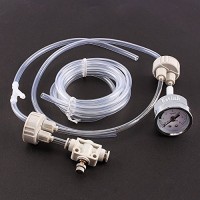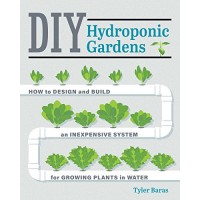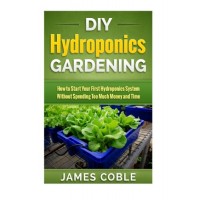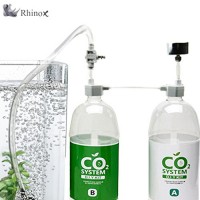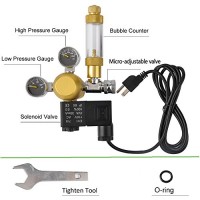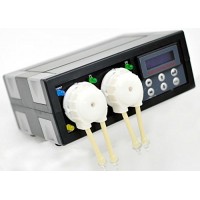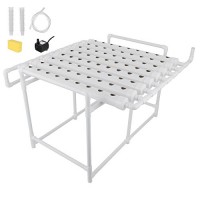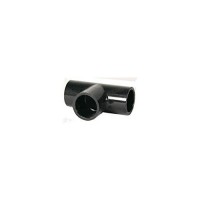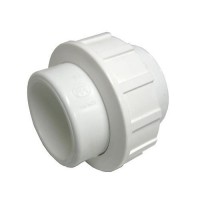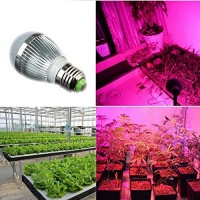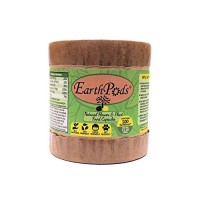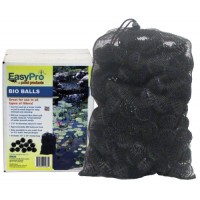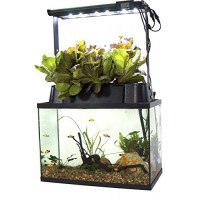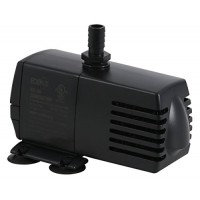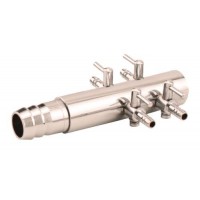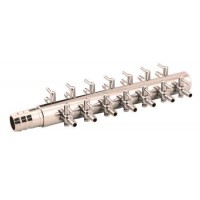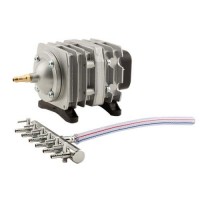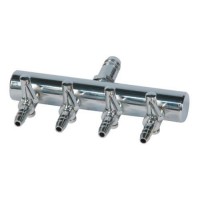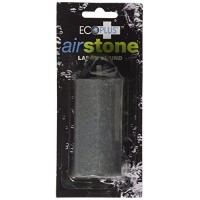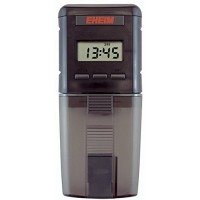Aquaponic Supplies
Aquaponics can be defined defined as a sustainable food production system that combines traditional aquaculture with hydroponics, with effluent from the water being used as nutrition for the plants. Despite the technical sounding nature of the description and etymological origins of quaponics, a rudimentary DIY aquaponics system is very easy to install by someone with basic skills in their own backyard or property. Complete kits are also sold that come with all basic growing tubs, plumbing systems and pumps if you prefer to get your start with a complete turn-key system.
For self sustenance or off the grid living or just as an experiment in natural life cycles aquaponics is a compelling field for the hobbyist or serious forward thinker interested in sustainable farming practices. Latest Books on Aquaponics
Refine Search
DIY CO2 Generator Aquarium Plant System Kit D201 Tube Valve Guage Bottle Cap for Aquarium Moss Plant
Description: CO2 plays an indispensable role to the photosynthesis of aquatic plants, but the aquarium can not provide a genuine environment for plants' growing, so it comes even important for adding ..
DIY Hydroponic Gardens: How to Design and Build an Inexpensive System for Growing Plants in Water
DIY Hydroponic Gardens takes the mystery out of growing in water. With practical information aimed at home DIYers, author Tyler Baras (Farmer Tyler to his fans) shows exactly how to build, plant, and ..
DIY Hydroponics Gardening: How to make Your First Hydroponics System without Spending too Much Money or Time
Learn About Hydroponics Today! (WITH PICTURE & DIAGRAM INCLUDED) Did you ever think about how it would be like to grow your own fruits and vegetables without taking up too much space? Do you thin..
DIY Pressurized CO2 System --- Effective CO2 Generator Kit by SunGrow - Includes caps, valves, 3-way connector, tubing & pressure gauge - Creates a...
How do I set up the CO2 kit?Start by labeling one bottle as "A" and other as "B". In Bottle A, add 200g citric acid (or 200ml of vinegar) to 600ml of water (1:3) and shake until well mixed. In Bottle ..
DLAND Digital PH Meter + TDS Tester Aquarium Pool Hydroponic Water Monitor 0-9999 PPM
Description: 1,This digital pen style PH meter is an ideal instrument for any aquarium, the fishing industry, swimming pools, school laboratories, food & beverage, etc. And, this Digital TDS Water ..
DoubleSun Hydroponics Aquarium CO2 Regulator Made of Brass-Bubble Counter Check Valve Fits Standard US Tanks and Flow Meter Adjusted Easily-Maintai...
You know the carbon dioxide is very important to plants and I know you need the hydroponics CO2 regulator.Dual guage will shows you inlet pressure and output pressure that will always tell you working..
DP2 Jebao/Jecod Auto Dosing Pump Automatic Doser for Aquariums
The DP-2 is a new, affordable dosing pump with 2 dosing heads. You can program each pump to come on up to 24 times a day and dispense a precise amount of solution, which allows a user to keep their ta..
DreamJoy Hydroponic Grow Kit 72 Site 8 Pipe NFT PVC Hydroponic Pipe Home Balcony Garden Grow Kit Hydroponic Soilless Plant Growing Systems Vegetabl...
Hydroponic Grow Kit 72 Sites 8 Pipes Hydroponic Planting Equipment Ebb and Flow Deep Water Culture Balcony Garden System Vegetable Tool Grow Kit This hybrid model can be Ebb and Flow type when using a..
Dura 401-020B 2" Slip SCH40 PVC Tee Fitting - Black 401020B
Dura 401-020B 2" Slip SCH40 PVC Tee Fitting - BlackBlack 2In Tee..
Dura 457-015 1.5"Slip SCH40 PVC Fitting 457015
Dura 457-015 1.5"Slip SCH40 PVC FittingSxs Union 1 1/2In Wht Sch40..
E27 LED Plant Grow Light Supplement Lamp Full Spectrum for Indoor Hydroponic Plant Vegetable Cultivation Horticulture Industrial
Description: Item type: LED Plant Grow Light Light color: Full spectrum Lamplight source type: LED Quantity of LED beads: 8 Power: 5W Input voltage: AC85V-265V Level of protection: ip42 Specification ..
EarthPods Premium Biological Organic Plant Food & Flower Fertilizer Capsules (70+ Minerals & Nutrients, High % Humic/Fulvic Acids & Beneficial Natu...
DIRECTIONS FOR USE: (for optimal comprehensive results, we suggest watering weekly with TeaDrops® liquid plant food packets & feeding EarthPods® fertilizer capsules every few weeks as a regular fertil..
EasyPro BB05 Bio-Balls Filter Media for Ponds
These plastic bio-balls are a great media for use in all types of filters. can be used as a loose media or in mesh bags for easy removing and cleaning. includes a free mesh bag. this product will not ..
ECO-Cycle Aquaponics Indoor Garden System with LED Light Upgrade
The ECO-Cycle Aquaponics Kit is a closed loop system allowing you to grow organic produce or decorative plants in your home, classroom, or office.---------Easily turn your aquarium into a productive g..
EcoPlus 160 GPH (605 LPH, 10.5W) Submersible Water Pump w/ 6 ft Power Cord | Aquarium, Fish Tank, Fountain, Pond, Hydroponics
These submersible water pumps are great for everything from fountains to hydroponic systems. The pumps have an inside threaded fittings and the flow is non-adjustable. Powerful oil-free, rare earth ro..
EcoPlus 4-Valve Air Manifold Trumpet Style 1/2" Inlet
Air Manifolds allow the adjustment of air flow to four or more air stones or air diffusers in order to insure that equal air flow is provided to each air diffuser or air stone. The manifold has indivi..
EcoPlus 728020 Air Manifold Trumpet Style Pump, 1/2 Inlet 16 Valve Outlet by EcoPlus
Allows the adjustment of air flow to four or more air stones or air diffusers;The manifold has individual barbed valves which control the outlet of air to your air stones or diffusers;They also allow ..
EcoPlus 728450 1 to 18W Single Outlet Commercial Air Pump, 793 GPH
Widely used to provide oxygen in aquariums, fish farms and hydroponic systems. Includes chrome air manifold, ranging from four to sixteen outlets. Cylinders and pistons are made of excellent materials..
EcoPlus 728460 Air Manifold T-Style Pump, 1/4" Inlet to 4 Valve 3/16" Outlet
Air Manifolds allow the adjustment of air flow to four or more air stones or air diffusers in order to insure that equal air flow is provided to each air diffuser or air stone. The manifold has indivi..
EcoPlus Round Air Stone, Large
Eco Plus Large Round Air Stone - (3/8" fitting)Aerates and adds oxygen to the waterCirculates nutrients in the waterHelps to maintain an even water temperatureThis stone requires 10 liters of air per ..
All aquaponics systems are usually grouped into several components or subsystems responsible for the effective removal of solid wastes, for adding bases to neutralize acids, and for maintaining water oxygenation. The complexity of each aquaponic system varies on the size and types of plants and fish grown. Decorative aquaponic systems can be used indoors or small herb growing goldfish tanks can be set-up in kitchens but even if it is a large scale system with hundreds of kilos of fish living in multiple tanks containing thousands of gallons the systems remain fairly uniform in concept.
Typical components include:
1. Growth tank: the tanks for raising and feeding the fish;
2. Settling tank: a unit for catching uneaten food and detached biofilms, and for settling out fine particulates;
3. Biofilter: a place where the nitrification bacteria can grow and convert ammonia into nitrates, which are usable by the plants;
4. Hydroponics subsystem: the portion of the system where plants are grown by absorbing excess nutrients from the water;
5. Sump: the lowest point in the system where the water flows to and from which it is pumped back to the rearing tanks.
Latest Books on Aquaponics

